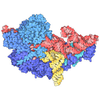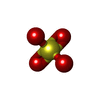+ Open data
Open data
- Basic information
Basic information
| Entry | Database: PDB / ID: 1i2m | ||||||
|---|---|---|---|---|---|---|---|
| Title | RAN-RCC1-SO4 COMPLEX | ||||||
 Components Components |
| ||||||
 Keywords Keywords | CELL CYCLE / beta-propeller / G fold or GTPase fold | ||||||
| Function / homology |  Function and homology information Function and homology informationpre-miRNA export from nucleus / RNA nuclear export complex / snRNA import into nucleus / sulfate binding / mitotic nuclear membrane reassembly / manchette / cellular response to mineralocorticoid stimulus / Regulation of cholesterol biosynthesis by SREBP (SREBF) / importin-alpha family protein binding / Rev-mediated nuclear export of HIV RNA ...pre-miRNA export from nucleus / RNA nuclear export complex / snRNA import into nucleus / sulfate binding / mitotic nuclear membrane reassembly / manchette / cellular response to mineralocorticoid stimulus / Regulation of cholesterol biosynthesis by SREBP (SREBF) / importin-alpha family protein binding / Rev-mediated nuclear export of HIV RNA / Nuclear import of Rev protein / regulation of mitotic spindle assembly / protein localization to nucleolus / NEP/NS2 Interacts with the Cellular Export Machinery / GTP metabolic process / tRNA processing in the nucleus / Postmitotic nuclear pore complex (NPC) reformation / MicroRNA (miRNA) biogenesis / nucleosomal DNA binding / DNA metabolic process / regulation of mitotic nuclear division / dynein intermediate chain binding / mitotic sister chromatid segregation / ribosomal large subunit export from nucleus / spermatid development / viral process / positive regulation of protein binding / sperm flagellum / nuclear pore / ribosomal subunit export from nucleus / nucleosome binding / spindle assembly / ribosomal small subunit export from nucleus / centriole / protein export from nucleus / regulation of mitotic cell cycle / guanyl-nucleotide exchange factor activity / condensed nuclear chromosome / mitotic spindle organization / male germ cell nucleus / hippocampus development / chromosome segregation / Transcriptional regulation by small RNAs / G1/S transition of mitotic cell cycle / recycling endosome / positive regulation of protein import into nucleus / small GTPase binding / protein import into nucleus / GDP binding / melanosome / nuclear envelope / mitotic cell cycle / chromosome / G protein activity / actin cytoskeleton organization / midbody / histone binding / Hydrolases; Acting on acid anhydrides; Acting on GTP to facilitate cellular and subcellular movement / cadherin binding / protein heterodimerization activity / protein domain specific binding / cell division / GTPase activity / chromatin binding / chromatin / GTP binding / protein-containing complex binding / nucleolus / magnesium ion binding / protein-containing complex / RNA binding / extracellular exosome / nucleoplasm / nucleus / membrane / cytoplasm / cytosol Similarity search - Function | ||||||
| Biological species |  Homo sapiens (human) Homo sapiens (human) | ||||||
| Method |  X-RAY DIFFRACTION / X-RAY DIFFRACTION /  SYNCHROTRON / SYNCHROTRON /  MOLECULAR REPLACEMENT / Resolution: 1.76 Å MOLECULAR REPLACEMENT / Resolution: 1.76 Å | ||||||
 Authors Authors | Renault, L. / Kuhlmann, J. / Henkel, A. / Wittinghofer, A. | ||||||
 Citation Citation |  Journal: Cell(Cambridge,Mass.) / Year: 2001 Journal: Cell(Cambridge,Mass.) / Year: 2001Title: Structural basis for guanine nucleotide exchange on Ran by the regulator of chromosome condensation (RCC1). Authors: Renault, L. / Kuhlmann, J. / Henkel, A. / Wittinghofer, A. | ||||||
| History |
|
- Structure visualization
Structure visualization
| Structure viewer | Molecule:  Molmil Molmil Jmol/JSmol Jmol/JSmol |
|---|
- Downloads & links
Downloads & links
- Download
Download
| PDBx/mmCIF format |  1i2m.cif.gz 1i2m.cif.gz | 233.2 KB | Display |  PDBx/mmCIF format PDBx/mmCIF format |
|---|---|---|---|---|
| PDB format |  pdb1i2m.ent.gz pdb1i2m.ent.gz | 183.4 KB | Display |  PDB format PDB format |
| PDBx/mmJSON format |  1i2m.json.gz 1i2m.json.gz | Tree view |  PDBx/mmJSON format PDBx/mmJSON format | |
| Others |  Other downloads Other downloads |
-Validation report
| Summary document |  1i2m_validation.pdf.gz 1i2m_validation.pdf.gz | 474.8 KB | Display |  wwPDB validaton report wwPDB validaton report |
|---|---|---|---|---|
| Full document |  1i2m_full_validation.pdf.gz 1i2m_full_validation.pdf.gz | 498.8 KB | Display | |
| Data in XML |  1i2m_validation.xml.gz 1i2m_validation.xml.gz | 45.6 KB | Display | |
| Data in CIF |  1i2m_validation.cif.gz 1i2m_validation.cif.gz | 64.2 KB | Display | |
| Arichive directory |  https://data.pdbj.org/pub/pdb/validation_reports/i2/1i2m https://data.pdbj.org/pub/pdb/validation_reports/i2/1i2m ftp://data.pdbj.org/pub/pdb/validation_reports/i2/1i2m ftp://data.pdbj.org/pub/pdb/validation_reports/i2/1i2m | HTTPS FTP |
-Related structure data
| Related structure data | 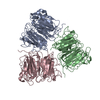 1a12S S: Starting model for refinement |
|---|---|
| Similar structure data |
- Links
Links
- Assembly
Assembly
| Deposited unit | 
| ||||||||
|---|---|---|---|---|---|---|---|---|---|
| 1 | 
| ||||||||
| 2 | 
| ||||||||
| 3 |
| ||||||||
| Unit cell |
|
- Components
Components
| #1: Protein | Mass: 24456.105 Da / Num. of mol.: 2 Source method: isolated from a genetically manipulated source Source: (gene. exp.)  Homo sapiens (human) / Plasmid: PGEX-2T / Species (production host): Escherichia coli / Production host: Homo sapiens (human) / Plasmid: PGEX-2T / Species (production host): Escherichia coli / Production host:  #2: Protein | Mass: 42917.402 Da / Num. of mol.: 2 Fragment: PROTEIN TRUNCATED FROM THE N-TERMINAL RESIDUES 1 TO 19 Source method: isolated from a genetically manipulated source Source: (gene. exp.)  Homo sapiens (human) / Plasmid: PTAC / Production host: Homo sapiens (human) / Plasmid: PTAC / Production host:  #3: Chemical | #4: Water | ChemComp-HOH / | |
|---|
-Experimental details
-Experiment
| Experiment | Method:  X-RAY DIFFRACTION / Number of used crystals: 4 X-RAY DIFFRACTION / Number of used crystals: 4 |
|---|
- Sample preparation
Sample preparation
| Crystal | Density Matthews: 1.96 Å3/Da / Density % sol: 37.37 % | |||||||||||||||
|---|---|---|---|---|---|---|---|---|---|---|---|---|---|---|---|---|
| Crystal grow | Temperature: 293 K / Method: vapor diffusion, hanging drop / pH: 6.5 Details: 20-10% PEG 4000, 200 mM potassium fluoride, 25 mM potassium phosphate, 25 mM ammonium sulfate, 2 mM EDTA, 3mM DTE, pH 6.5, VAPOR DIFFUSION, HANGING DROP | |||||||||||||||
| Crystal grow | *PLUS Temperature: 20 ℃ | |||||||||||||||
| Components of the solutions | *PLUS
|
-Data collection
| Diffraction |
| ||||||||||||||||||
|---|---|---|---|---|---|---|---|---|---|---|---|---|---|---|---|---|---|---|---|
| Diffraction source |
| ||||||||||||||||||
| Detector |
| ||||||||||||||||||
| Radiation |
| ||||||||||||||||||
| Radiation wavelength |
| ||||||||||||||||||
| Reflection | Resolution: 1.63→19.79 Å / Num. all: 123475 / Num. obs: 484600 / % possible obs: 92.3 % / Observed criterion σ(F): 0 / Redundancy: 4.1 % / Biso Wilson estimate: 23.7 Å2 / Limit h max: 30 / Limit h min: -30 / Limit k max: 42 / Limit k min: -30 / Limit l max: 47 / Limit l min: 0 / Observed criterion F max: 156076284.73 / Observed criterion F min: 1060.6 / Rmerge(I) obs: 0.146 / Net I/σ(I): 6.8 | ||||||||||||||||||
| Reflection shell | Resolution: 1.63→1.67 Å / Redundancy: 1.5 % / Rmerge(I) obs: 0.316 / Mean I/σ(I) obs: 0.8 / % possible all: 56.1 | ||||||||||||||||||
| Reflection shell | *PLUS % possible obs: 56.1 % |
- Processing
Processing
| Software |
| ||||||||||||||||||||||||||||||||||||||||||||||||||||||||||||||||||||||||||||||||||||||||||||||||||||||||||||||||||||||||||||||||||||||||||||||||||||||||||||||||||||||||||||||||||||||||||||||||||||||||||||||||||
|---|---|---|---|---|---|---|---|---|---|---|---|---|---|---|---|---|---|---|---|---|---|---|---|---|---|---|---|---|---|---|---|---|---|---|---|---|---|---|---|---|---|---|---|---|---|---|---|---|---|---|---|---|---|---|---|---|---|---|---|---|---|---|---|---|---|---|---|---|---|---|---|---|---|---|---|---|---|---|---|---|---|---|---|---|---|---|---|---|---|---|---|---|---|---|---|---|---|---|---|---|---|---|---|---|---|---|---|---|---|---|---|---|---|---|---|---|---|---|---|---|---|---|---|---|---|---|---|---|---|---|---|---|---|---|---|---|---|---|---|---|---|---|---|---|---|---|---|---|---|---|---|---|---|---|---|---|---|---|---|---|---|---|---|---|---|---|---|---|---|---|---|---|---|---|---|---|---|---|---|---|---|---|---|---|---|---|---|---|---|---|---|---|---|---|---|---|---|---|---|---|---|---|---|---|---|---|---|---|---|---|---|
| Refinement | Method to determine structure:  MOLECULAR REPLACEMENT MOLECULAR REPLACEMENTStarting model: PDB ENTRY 1A12 (RCC1) and human Ran-GDP-Mg2+ structure (Scheffzek, K. et al. (1995)) Resolution: 1.76→19.79 Å / Rfactor Rfree error: 0.002 / Occupancy max: 1 / Occupancy min: 1 / Cross valid method: THROUGHOUT / Stereochemistry target values: Engh & Huber
| ||||||||||||||||||||||||||||||||||||||||||||||||||||||||||||||||||||||||||||||||||||||||||||||||||||||||||||||||||||||||||||||||||||||||||||||||||||||||||||||||||||||||||||||||||||||||||||||||||||||||||||||||||
| Solvent computation | Solvent model: CNS bulk solvent model used / Bsol: 53.116 Å2 / ksol: 0.375011 e/Å3 | ||||||||||||||||||||||||||||||||||||||||||||||||||||||||||||||||||||||||||||||||||||||||||||||||||||||||||||||||||||||||||||||||||||||||||||||||||||||||||||||||||||||||||||||||||||||||||||||||||||||||||||||||||
| Displacement parameters | Biso max: 99.12 Å2 / Biso mean: 35.55 Å2 / Biso min: 13.32 Å2
| ||||||||||||||||||||||||||||||||||||||||||||||||||||||||||||||||||||||||||||||||||||||||||||||||||||||||||||||||||||||||||||||||||||||||||||||||||||||||||||||||||||||||||||||||||||||||||||||||||||||||||||||||||
| Refine Biso |
| ||||||||||||||||||||||||||||||||||||||||||||||||||||||||||||||||||||||||||||||||||||||||||||||||||||||||||||||||||||||||||||||||||||||||||||||||||||||||||||||||||||||||||||||||||||||||||||||||||||||||||||||||||
| Refine analyze |
| ||||||||||||||||||||||||||||||||||||||||||||||||||||||||||||||||||||||||||||||||||||||||||||||||||||||||||||||||||||||||||||||||||||||||||||||||||||||||||||||||||||||||||||||||||||||||||||||||||||||||||||||||||
| Refinement step | Cycle: LAST / Resolution: 1.76→19.79 Å
| ||||||||||||||||||||||||||||||||||||||||||||||||||||||||||||||||||||||||||||||||||||||||||||||||||||||||||||||||||||||||||||||||||||||||||||||||||||||||||||||||||||||||||||||||||||||||||||||||||||||||||||||||||
| Refine LS restraints |
| ||||||||||||||||||||||||||||||||||||||||||||||||||||||||||||||||||||||||||||||||||||||||||||||||||||||||||||||||||||||||||||||||||||||||||||||||||||||||||||||||||||||||||||||||||||||||||||||||||||||||||||||||||
| LS refinement shell | Refine-ID: X-RAY DIFFRACTION / Total num. of bins used: 20
| ||||||||||||||||||||||||||||||||||||||||||||||||||||||||||||||||||||||||||||||||||||||||||||||||||||||||||||||||||||||||||||||||||||||||||||||||||||||||||||||||||||||||||||||||||||||||||||||||||||||||||||||||||
| Xplor file |
| ||||||||||||||||||||||||||||||||||||||||||||||||||||||||||||||||||||||||||||||||||||||||||||||||||||||||||||||||||||||||||||||||||||||||||||||||||||||||||||||||||||||||||||||||||||||||||||||||||||||||||||||||||
| Software | *PLUS Name: CNS / Version: 1 / Classification: refinement | ||||||||||||||||||||||||||||||||||||||||||||||||||||||||||||||||||||||||||||||||||||||||||||||||||||||||||||||||||||||||||||||||||||||||||||||||||||||||||||||||||||||||||||||||||||||||||||||||||||||||||||||||||
| Refine LS restraints | *PLUS
|
 Movie
Movie Controller
Controller




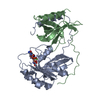
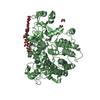
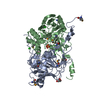

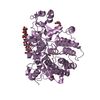


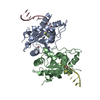
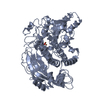
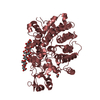

 PDBj
PDBj

